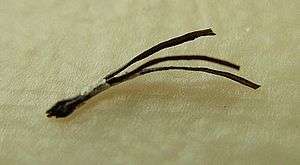Pili multigemini
Pili multigemini, also known as "compound hairs"[2] or a “wood hair”, is a malformation characterized by the presence of bifurcated or multiple divided hair matrices and papillae, giving rise to the formation of multiple hair shafts within the individual follicles.[3]:768[4]
| Pili multigemini | |
|---|---|
| Other names | Pili gemini[1] |
 | |
| An extracted pili multigemini with three distinct hairs growing from the same source. | |
| Specialty | Dermatology |
Description
The name describes a condition where several separate hair fibers bunch together and emerge from the skin through a single hair canal. The hair looks like a bunch of flower stalks in a vase. Pathology shows that deep in the skin several dermal papilla are closely situated with each producing a fiber, but these separate hair follicle bulbs combine together into one hair canal towards the skin surface. Folliculitis can sometimes be associated with this condition.[2]
Treatment
Electrolysis will permanently remove pili multigemini. Depilating laser treatment has been suggested to improve symptomatic pili multigemini.[5]
References
- RESERVED, INSERM US14-- ALL RIGHTS. "Orphanet: Pili gemini". www.orpha.net. Retrieved 27 April 2019.
- McElwee, Kevin J. "pili multigemini". www.keratin.com. Retrieved 2019-10-28.
Pili multigemini hair follicles, also called 'compound hairs', are considered rare although there have been no studies to define the actual frequency in the general population.
- James, William; Berger, Timothy; Elston, Dirk (2005). Andrews' Diseases of the Skin: Clinical Dermatology. (10th ed.). Saunders. ISBN 0-7216-2921-0.
- Rapini, Ronald P.; Bolognia, Jean L.; Jorizzo, Joseph L. (2007). Dermatology: 2-Volume Set. St. Louis: Mosby. ISBN 978-1-4160-2999-1.
- Naysmith, L., De Berker, D. and Munro, C.S. (2001), Multigeminate beard hairs and folliculitis. British Journal of Dermatology, 144: 427–428. doi: 10.1046/j.1365-2133.2001.04047.x